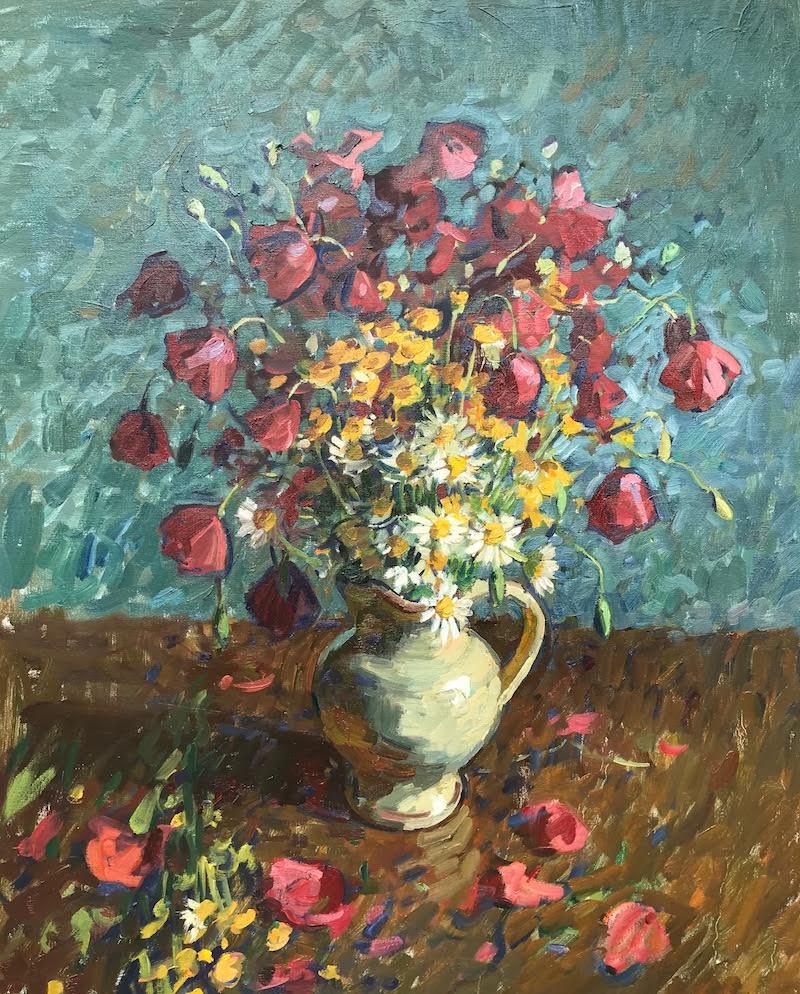Ben Fenske is currently in New York for the opening of his exhibition at the Grenning Gallery. I caught up with him on the phone, as I sat in Tuscany, in the place where I had last seen Ben, for the second part of his interview. We started with the largest painting in the exhibition, 47.25 x 66.9 inches, titled ‘Andrà Tutto Bene’. A title that mirrors the banners and signs that appeared all over Italy during the height of the COVID pandemic, a hopeful message alongside a rainbow that translates “Everything will be alright.” In Ben’s painting, a woman lays in the sun in an olive grove. On the horizon is a dark sky with a distant rainbow offering us hope in the midst of the storm. I asked Ben where the inspiration for this painting came from:

“I like the imagery. I love that Wyeth painting, ‘Distant Thunder’. I’ve always liked it. It’s one of those paintings where the title really adds something to the painting. It’s a woman lying on the grass. There’s no indication of thunder or storms or anything, but I like the imagery that the title creates in your mind. A sunny field, but then there’s this dark sky. Which is also a nice effect, a light effect that I like to paint. My title doesn’t have any overt meaning, I just thought it was interesting, I kept seeing all these rainbows on banners everywhere. It just came to me that I wanted to call it that.
“I had started a painting almost five years ago of that same subject and abandoned it and then worked on it again a few times. Then this year in the spring I wanted to do a bigger one and start over and I made a sketch on site with the model. I took that back and I made a sketch in the studio to try to think about the composition I wanted. Then I painted everything on site with the model. I had a false start, the first day I placed everything wrong on the canvas, too close to the bottom. I didn’t like it and I stretched a new canvas that was a little bit longer and I started again. I think I worked on it for 8 sessions in total.”
How do you feel about the whole collection of your paintings this year?
“I’ve done a lot of paintings this year, most of them are not in the exhibition. I’m happy with some of the big still lifes, those were big paintings. I like painting people outside, so that’s always fun and challenging and gives me ideas for other stuff I want to do – bigger more ambitious paintings.”

Which colors are currently on your palette?
“Titanium white, yellow ochre, cadmium yellow, cadmium red, cadmium orange, ultramarine, transparent brown or red, phthalo green.”
What are you painting today?
“I’m going to Shelter Island to paint. I’ll try to get the right angle, see if the right boats are there, and work on that. Other than that, I need to go into the forest and work out a sketch there. I’ll do a fairly big sketch. I’m just getting some paintings going, I usually start a bunch and then work on whatever I feel like working on depending on the time of day and the weather.”
How do you start a painting?
“Some of it is just going out and looking for something to paint and doing sketches. I’ll see something I like and I’ll paint it, or I’ll have an idea in my mind. I’ll have a specific thing I’m looking for and I’ll go out and I’ll try to find that. If I can’t find it then I’ll try to figure out another way to do it. Whether it’s outside or inside, when I paint from life, I try to get the right time of day and to paint during the same time of day, with the same weather conditions. I’ll spend maybe 2 hours on it then come back another day. I usually have a lot of paintings going, and a lot will be abandoned or painted over. Some will be saved because I like something about it, maybe I could use this same idea but improve the composition or start over, maybe I want to make it bigger. There’s no rhyme or reason to it.”
‘Sturgeon Moon’ was painted in Italy from your imagination, inspired by a scene in New York. What was the process for this painting?
“I had a sketch from last year that I started here in the Hamptons. I started an 80 by 100cm painting on site in the dark over the course of a couple of nights but I made it too dark, I didn’t want to keep going on it but a year later I wanted to make something out of that idea. There’s something really unsatisfying about painting outside on the spot because it’ll never be the painting I want it to be, a lot of the time it’s better to not be there, to not have that much information. I wanted to see what would happen if I made it up. I’m attracted more to paintings that are a little bit weirder, a little more art. I don’t ever want to use photographs because the temptation would be to copy it which is completely boring to me. I try to think of the idea I had in my mind when I first wanted to paint it. The painting is a little weird, but I like the direction it took. I didn’t know what to expect when I started painting it, it took a weird direction, strange colors, it just gives me more ideas about how I’ll do it next time or how I’d do it differently.”

Do you find there are limitations to painting from life?
“Definitely. I’ve started going in that direction a bit, I need to. For so many years I’d paint sketches and I thought I was doing these sketches to build up that information and those ideas, about light and composition, and that one day I can do these other types of paintings. Now I realize that basically you get good at what you practice. I’m fairly good at painting what’s in front of me, I need more practice making pictures instead.
“All the still life I paint now I don’t set everything up. The first day I’ll start putting things on the canvas where I think I want them to go and work out the composition in a rough way, and when I need to move things, I will. So it’s not really the scene that’s in front of me, I spend more time looking at the painting. The danger of painting from life is that you end up copying things and you can lose the image that you had in your mind of how you wanted the painting to be. It’s always like that outside because everything changes so fast, so you’re kind of making it up, if you don’t it becomes really dead because if you try to copy the individual elements it doesn’t really work together. I just love Van Gogh, I never used to like his work. When I was 20 years old, I thought he sucked, but now I see so much strength in it, so much art. So many paintings lack art.”
I can see the influence of Van Gogh in your flower paintings, particularly his ‘Bouquet of flowers in a vase’. Were you thinking about that painting when you set up ‘Wildflowers’?
“I started a bunch of paintings of poppies, but it was a bad year, they didn’t really stay around. It was too dry for wildflowers. They wouldn’t stay, after an hour they’d be gone. On a flower painting that means you keep changing and adding because you need to get new flowers every day, so it’s never all in front of you. I would like to see how Van Gogh painted that big bunch of flowers. I’ve seen it in real life it’s really built up and layered, he looked like he worked on it a lot and kept adding stuff, whereas his other paintings were often one shot. That’s the thing about still life, I like putting something down and putting it away for a while and thinking about how I can improve the composition.
“Paintings often become more interesting the more you paint on them. They are best when they are either a one-shot painting or worked on over many, many sessions. Often if I have a two-shot painting, I’ll take something that’s a good sketch and I’ll ruin it. It would’ve been better leaving it as a sketch. If I have ten sessions, I can actually make something out of it. I like the idea of doing something either all in one go or over the course of months or weeks, changing things, coming back with a fresh take to improve it.”

How did this series of paintings challenge you?
“It’s fun to have different challenges. The big table one, ‘Table, Toricella’, I thought how am I going to paint this thing? I can barely fit the canvas in the kitchen, it’s 2 meters long, there’s no place to back up. I had to set the canvas on a chair which meant I could only see half the canvas at a time because the table was blocking it from my vantage point. I had to make up the perspective because I was too close to it. I wanted each of the objects to have their own perspective, I didn’t want to force it, for the object in front to be enormous, so I downplayed the perspective to get the right feeling from it, that was the fun part, the interesting part. That is always my idea when I’m painting still life. Initially, I wanted the table to be slanted. Usually, my still life has that slant, it’s more casual, it’s more how you see the world, you’re almost never perpendicular to a horizontal surface, you have to be right there, dead on zero to see it that way so I always put a bit of slant in, but that one I wanted to make it straight across. I think about the overall color scheme, I start reinforcing that color scheme a bit, I usually try to find three colors for a painting, maybe four.”
What is next?
“I have my goals I’m slowly working towards. Maybe I’ll get to some of them before I die. There are paintings that I want to do and to continue to improve. That’s what’s next for me. My goal was always to do paintings of people and then bigger paintings and something along the lines of Arkady Plastov. I would love to do that. I’m slowly working my way there. For a while I thought I needed to study anatomy before I did that, so I did. There was always something else, another skill I wanted to work on, but it’s taken me a long time.”
What is the role of oil painting today?
“It’s something you decorate your house with or something people feel. It’s fun to look at. That’s the role it plays. If I go to a museum or look at paintings in a book, I just like to look at them. It’s like music for the eyes instead of the ears. Visual poetry. Something that people like. Some people are attracted to things because of a nostalgic aspect, it reminds them of a place they used to live or a place they like. The painting I do is something I like to paint, and I need to do it, and it serves that function, then hopefully someone wants to buy it and they can enjoy it. Enjoy looking at it from time to time.”



Leave A Reply